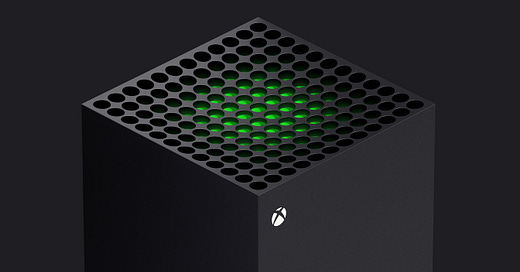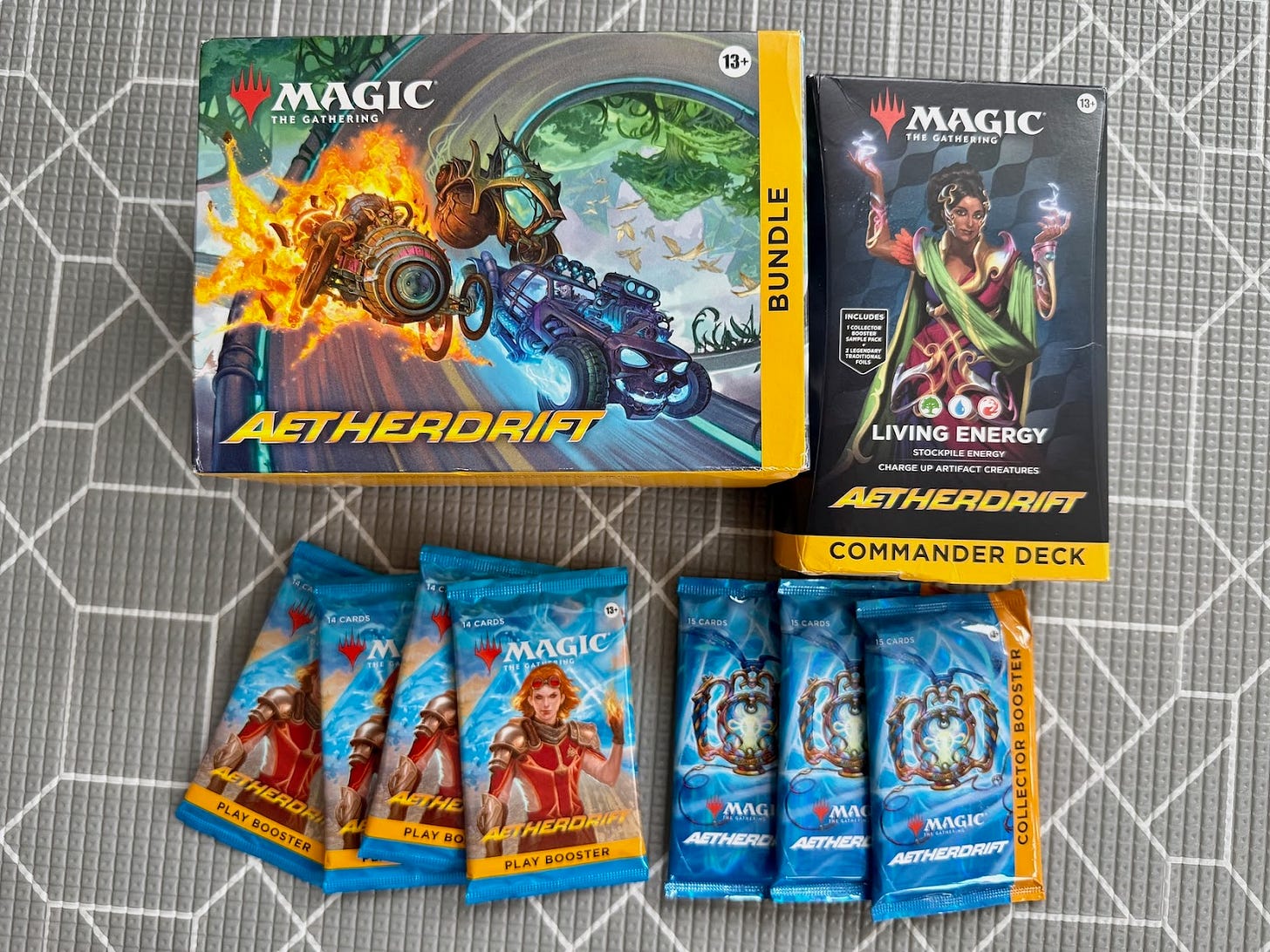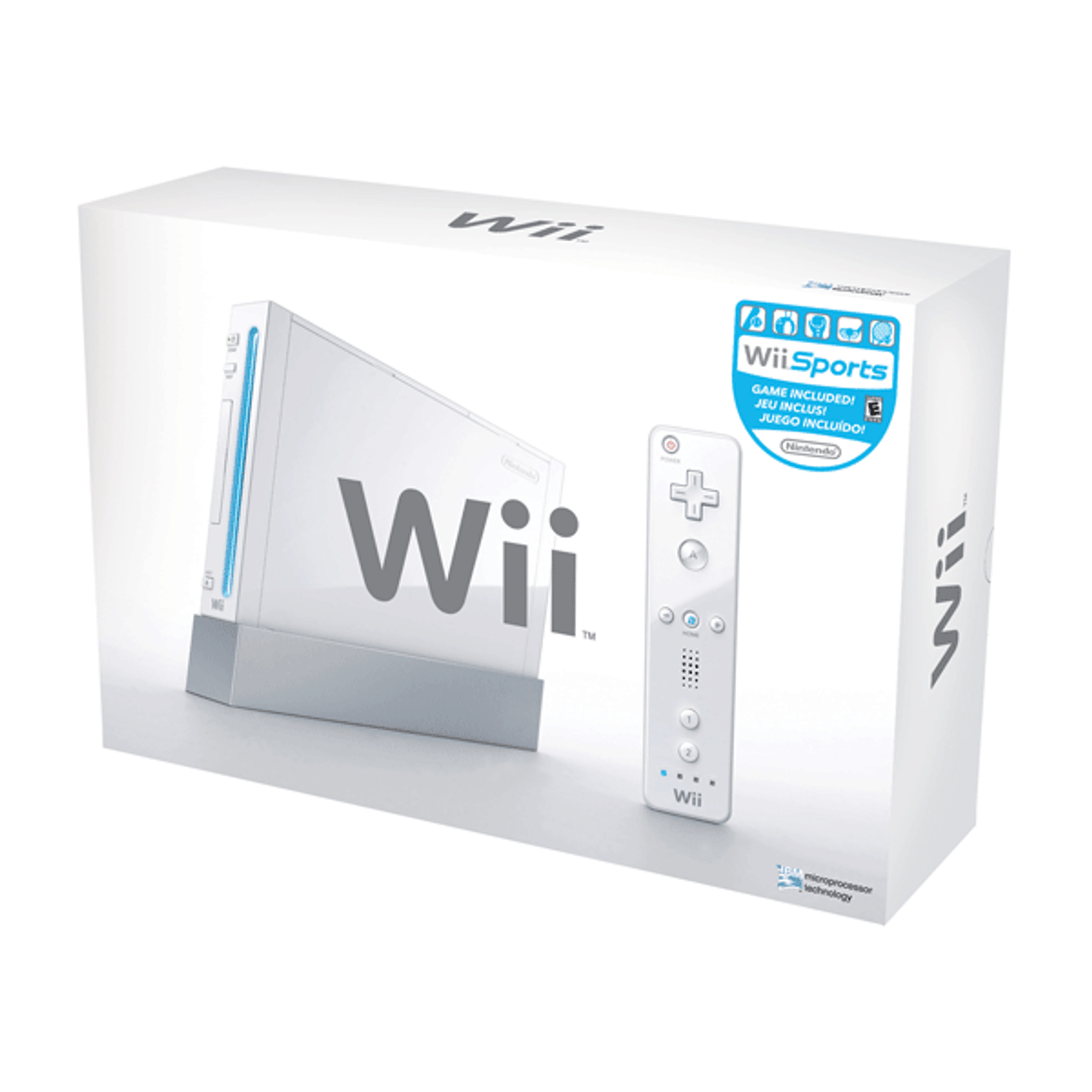Xbox is going to be fine
Plus Pokemon TCG Pocket's trade troubles, MtG racing and revisiting the Wii.
Hello there! Valentine’s Day is this week, and to be honest I’m always let down by the lack of amorous video games claiming the Feb 14 release date. I know it’s next-to-impossible for smaller games to aim for and hit a precise date, but this year I really thought Date Everything was going to do it. This is a dating sim where you can romance anthropormorphised versions of household objects, emotions and even abstract concepts. Unfortunately it’s been delayed to June owing to too many nasty technical glitches. On the plus side, the devs are promising you will be able to date the glitches.
This week, we’re again discussing the future of Xbox, as well as ripping open a bunch of boosters both digitally and physically and also confronting mortality by realising how poorly the Wii has aged. Let’s go!
Console wars will soon be as redundant as DVD player wars
By Tim
A lot has been made recently (and, in fact, over the last decade) of the way Microsoft is shifting its gaming strategy. Publishing games outside its own console has been seen by some as a death knell for the Xbox brand, and the beginning of a transition that will ultimately lead to the company purely making games for PC and PlayStation. But I don’t see it that way.
Console video games are and have been unusual in the consumer tech space, with publishers making software for a small number of proprietary machines, which with a few small exceptions have been operated by just four big corporations. Even as the broad standards of PC and phone gaming have exploded (and are currently growing, unlike the console space), players have clung to the 1990s idea of console wars when regarding the strengths of current platforms.
With most upcoming Microsoft-published games set to come to Xbox and PC as well as PS5 (and likely Switch 2), you will have seen arguments that an Xbox console is now meaningless. That’s because we’ve used exclusive games to measure the worth of a system for decades. But that’s not how it’s going to be in the near future.
Console video games are going to become increasingly niche as ubiquitous service games take up more space, and projecting into the future a bit more I think hardware platforms themselves will become the realm of enthusiasts only. Microsoft’s moves have been driven by a desire to get out in front of that change, rather than battle with Sony to see who can sell the most boxes. Comparisons between Microsoft and 2000s Sega couldn’t be more misguided; we’re talking about a $US3 trillion giant here; at a high level Microsoft likely doesn’t even consider Sony to be a competitor. But all this doesn’t mean Xbox consoles die.
Look at practically any other consumer tech vertical. Does Apple stop making laptops because it doesn’t sell as many as Dell? No. Microsoft still makes Surface computers, and they sell far fewer than either! And the idea that Surface would sell better if Microsoft didn’t allow Office on other brand’s laptops is absurd.
Microsoft has never made a console that outsold the competition overall (and I’ll note that the closest it came was the Xbox 360, due in large part to the company’s services infrastructure), and it never will. But I’m betting it keeps making them for a while, even if more players experience its games elsewhere.
What to play
Several games have been freshly added to the standard Game Pass tier, including two that are entirely new to Game Pass; Far Cry New Dawn andJRPG Eiyuden Chronicle: Hundred Heroes. But the biggest news is that Bethesda epic Starfield has moved from Ultimate down to Standard, alongside cartoon soulslike Another Crab’s Treasure. Those with Ultimate also now have access to Madden NFL 25.
If you haven’t been keeping up with Nintendo Switch Online, so far this year we’ve seen three additions to the SNES lineup (fighter Fatal Fury 2, ARPG Super Ninja Boy and obscure Nintendo side-scrolling puzzler Sutte Hakkun), as well as a single N64 game in Ridge Racer 64. Later this week the GBA app will gain one of the system’s greats: exploration platformer Wario Land 4.
The Sims is old now, and you are too, so you should pick up some of the expansions for The Sims 4 in the current sale (which ends today). My (Alice) picks are: Life & Death, Growing Together, Vampires, Realm of Magic and Seasons.
Currently free on Epic Games, Sega’s Humankind is an interesting alternative while you wait for Civilization VII to sort its issues.
Dear DeNA: the “T” in TCG stands for trading
By Alice
I think I need to admit that I’m just fully addicted to Pokemon TCG Pocket now. Or, at least I was, before greed ruined everything. Whether or not the greed is mine is open to interpretation, but I like to think it’s the greed of DeNA (and most of the subreddit agrees with me).
The third set of boosters for the game were released the week before last, and the game has now fully leaned into the fourth generation of Pokemon, most of which I have never heard of.
Alongside the new booster packs, came the promised ability to trade cards with friends. People had been keenly anticipating this update, because the “T” in “TCG” is really a key part of the experience. Blind opening packs means we all have a tonne of duplicates and a half-empty Pokedex. Many people had created alt accounts to get even more cards, so they could effectively trade with themselves.
Unfortunately, being a free to play game, DeNA (the makers of the game) did not appreciate this ingenuity, and made the trade system so restrictive as to make it unusable. You can’t trade the rarest tiers of cards, you can only trade cards of the same tier, and you have to consume a lot of trade tokens. The way to get those trade tokens is to destroy rare cards. To trade a regular EX card, you need to trash two of the rarest cards in the game, which really doesn’t seem worth it.
There’s been a huge outcry in the player community, and DeNA have said that they’re going to consider changing it, but one wonders how anyone thought this design was reasonable in the first place? It’s clear that they don’t actually want players to be able to trade cards, so why promise the feature in the first place?
The rest of the game is very good, however this trade furore has left a bad taste in the mouths of many players. We’ll see what happens next.
Bricks, Boards and Beginnings
by Alice
While we’re on the topic of trading card games, the latest Magic the Gathering set, Aetherdrift, had its pre-release events last week. I went to one at Plenty of Games in the CBD, and as always I was struck by just how much I love this passionate community, and how good it is that small game stores like this still exist. After so many closed before and during the lockdown phases of the current COVID-19 pandemic, I was worried that they would die out completely. Having places to go like this, where anyone can walk in with a deck (or money to buy a deck) and find other people to play with is truly wonderful, and can never be taken for granted.
Anyway, the game. The Aetherdrift expansion is a bit of a weird one. Wizards of the Coast have been trying all kinds of unusual stuff to see what works lately, and I love that for us. The theme here is “a multiversal race filled with adrenaline-fueled Magic gameplay across three planes” and, sure, this may as well happen.
You select a “team” to play for out of 10 two-colour options, each with their own moves. At pre-release I played a blue/black deck, which was a major departure from my usual green/white style, but that’s sometimes just how sealed goes. Unfortunately, all my cards that played into the new “start your engines” mechanic kept getting milled by the other blue players. So, while all my opponents were at full speed (once your engine has been started, you go up a gear each turn when an opponent loses life, and then some of your cards have extra abilities when at full speed), I remained at the starting line. This sucked, because it meant I couldn’t do any cool stuff, but was secretly very useful because it meant that all my opponents underestimated me, and I managed to Steven Bradbury my way to victory.
I’m still not sure how I feel about this new set. On the one hand, I appreciate Wizards restraint at not throwing the kitchen sink at the new mechanics. But at the same time, I think they might have been a little too restrained. There are some fun places this could have gone.
All up, though, the art was beautiful, and there’s enough meat in the cards that they’re worth trying.
Retro Esoterica
by Tim
The Nintendo Wii, I hate to say, is now 18 years old. In its adulthood the machine has become a very popular all-in-one retro device, even among players who were not yet born when it released. This is because there are millions of Wiis around for low cost, they’re comically easy to hack using nothing but a PC web browser, and they output a range of old video resolutions including 240p so you can hook them up to CRTs to emulate many classic consoles.
But, how do Wiis hold up in 2025 if you actually want to play Wii games? Unfortunately, the answer is not too well.
The Wii was a massive mainstream hit, despite (and because) of its focus on accessibility over technology. Its huge user base was dominated by people who preferred Wii Sports over traditional games, or at least that’s how they were perceived by publishers, and hardware-wise it is not a capable machine by 2006 standards. These factors combine to make for a tough system to revisit.
Video output is 480p maximum via component cables, and yet most games are locked to a widescreen aspect ratio. That would be fine if they rendered natively at an appropriate resolution, but instead they render narrower and need to be stretched across the 16:9 canvas. Combined with a baked in blur, this makes the system hideous to scale on a modern TV.
Some games are genuinely worth dealing with the poor visuals, though thankfully the bulk of them are now available elsewhere in HD (we’re mostly just waiting on Super Mario Galaxy 2 and Kirby’s Epic Yarn, Nintendo). But a lot of the library is made up of simplified, juvenile designs centered around the Wii remote. In some cases the unique controller is very cool (the low-fi IR setup, assuming the ambient light in your room doesn’t wig it out, makes for a perfect pointer), but it’s overwhelmingly implemented so that thrusting it indiscriminately stands in for button presses, which is not fun.
Case in point, I think the Wii is home to the actual low point of the Sonic the Hedgehog series (and that’s saying something), with two games that pair massively cringey storybook narratives (based on Aladdin and King Arthur) with atrocious Wii remote waggle and smeary visuals. At least the music was cool.









